Southern Cross University: Crisis Communication in Management Report
VerifiedAdded on 2022/11/24
|8
|1976
|433
Report
AI Summary
This report examines the critical role of communication in organizational crisis management. It explores how effective communication fosters collaboration between management and stakeholders, enhancing an organization's ability to navigate crises. The research delves into the importance of internal communication for employee involvement in crisis processes and the significance of external communication for maintaining stakeholder trust, including customers, suppliers, and investors. The report emphasizes the need for a crisis preparation plan, highlighting the value of transparent and clear communication to build confidence and awareness among stakeholders. It further discusses communication strategies for crisis containment, emphasizing the need for employee engagement and the evaluation of mitigation strategies. The conclusion underscores the importance of communication in strengthening decision-making capabilities and enhancing operational transparency during times of crisis.
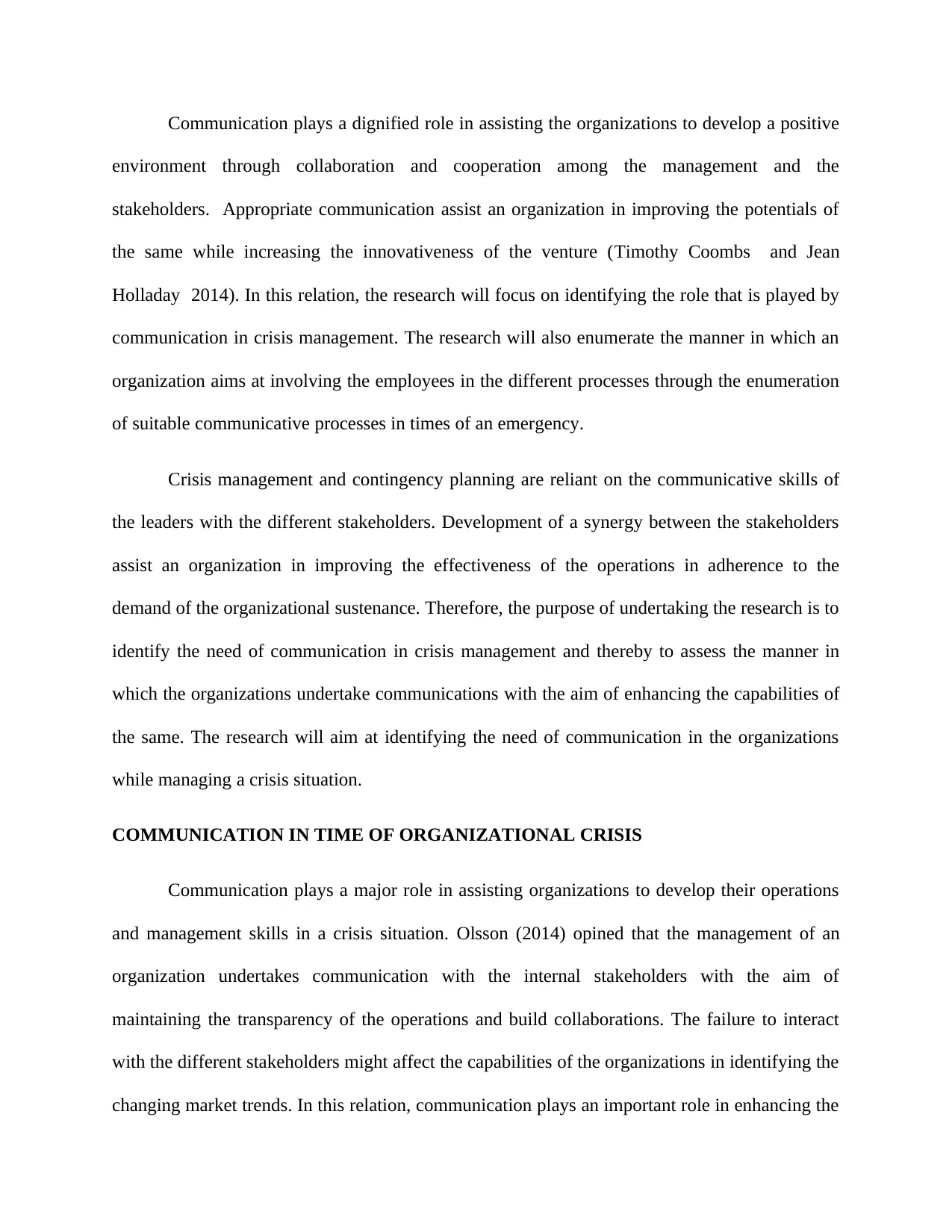
Communication plays a dignified role in assisting the organizations to develop a positive
environment through collaboration and cooperation among the management and the
stakeholders. Appropriate communication assist an organization in improving the potentials of
the same while increasing the innovativeness of the venture (Timothy Coombs and Jean
Holladay 2014). In this relation, the research will focus on identifying the role that is played by
communication in crisis management. The research will also enumerate the manner in which an
organization aims at involving the employees in the different processes through the enumeration
of suitable communicative processes in times of an emergency.
Crisis management and contingency planning are reliant on the communicative skills of
the leaders with the different stakeholders. Development of a synergy between the stakeholders
assist an organization in improving the effectiveness of the operations in adherence to the
demand of the organizational sustenance. Therefore, the purpose of undertaking the research is to
identify the need of communication in crisis management and thereby to assess the manner in
which the organizations undertake communications with the aim of enhancing the capabilities of
the same. The research will aim at identifying the need of communication in the organizations
while managing a crisis situation.
COMMUNICATION IN TIME OF ORGANIZATIONAL CRISIS
Communication plays a major role in assisting organizations to develop their operations
and management skills in a crisis situation. Olsson (2014) opined that the management of an
organization undertakes communication with the internal stakeholders with the aim of
maintaining the transparency of the operations and build collaborations. The failure to interact
with the different stakeholders might affect the capabilities of the organizations in identifying the
changing market trends. In this relation, communication plays an important role in enhancing the
environment through collaboration and cooperation among the management and the
stakeholders. Appropriate communication assist an organization in improving the potentials of
the same while increasing the innovativeness of the venture (Timothy Coombs and Jean
Holladay 2014). In this relation, the research will focus on identifying the role that is played by
communication in crisis management. The research will also enumerate the manner in which an
organization aims at involving the employees in the different processes through the enumeration
of suitable communicative processes in times of an emergency.
Crisis management and contingency planning are reliant on the communicative skills of
the leaders with the different stakeholders. Development of a synergy between the stakeholders
assist an organization in improving the effectiveness of the operations in adherence to the
demand of the organizational sustenance. Therefore, the purpose of undertaking the research is to
identify the need of communication in crisis management and thereby to assess the manner in
which the organizations undertake communications with the aim of enhancing the capabilities of
the same. The research will aim at identifying the need of communication in the organizations
while managing a crisis situation.
COMMUNICATION IN TIME OF ORGANIZATIONAL CRISIS
Communication plays a major role in assisting organizations to develop their operations
and management skills in a crisis situation. Olsson (2014) opined that the management of an
organization undertakes communication with the internal stakeholders with the aim of
maintaining the transparency of the operations and build collaborations. The failure to interact
with the different stakeholders might affect the capabilities of the organizations in identifying the
changing market trends. In this relation, communication plays an important role in enhancing the
Paraphrase This Document
Need a fresh take? Get an instant paraphrase of this document with our AI Paraphraser
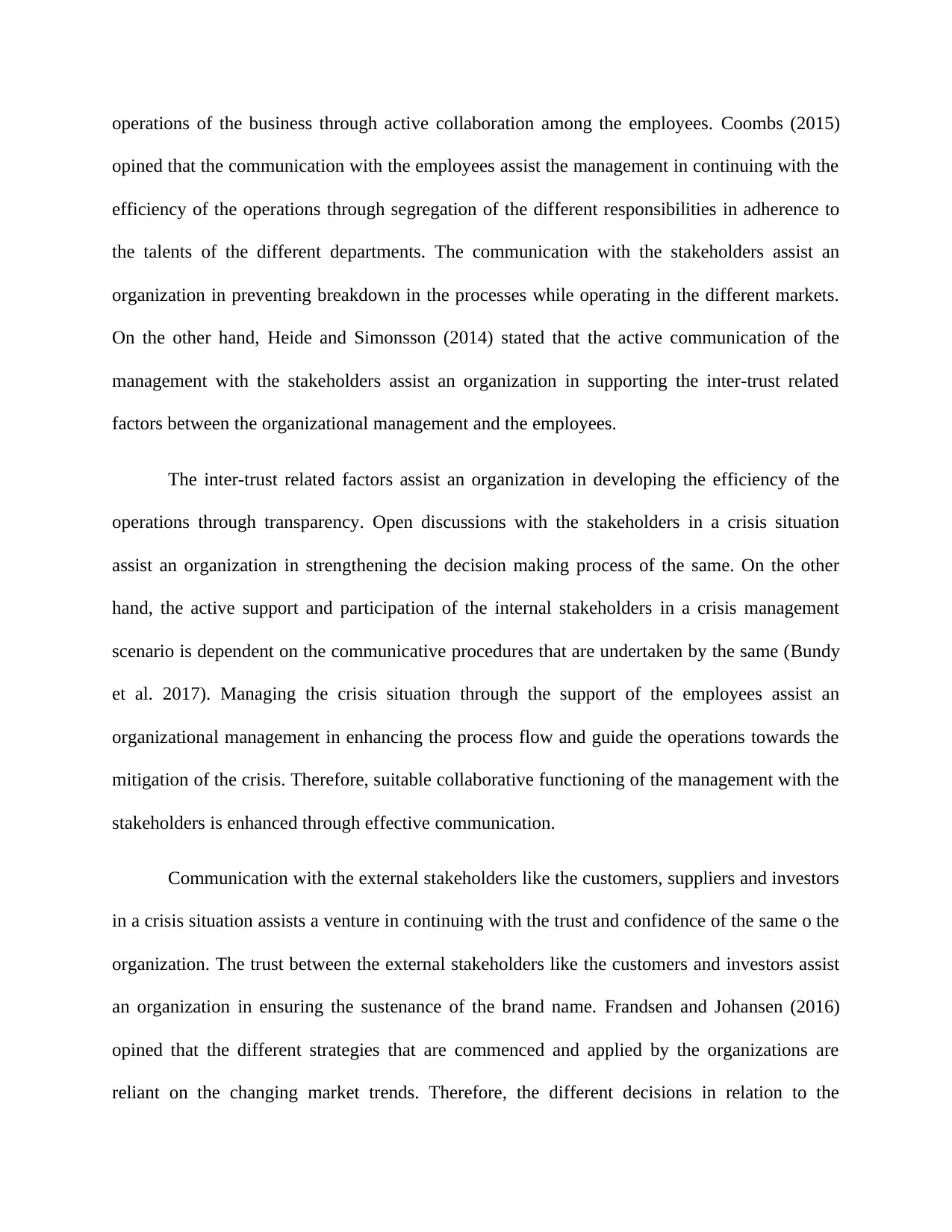
operations of the business through active collaboration among the employees. Coombs (2015)
opined that the communication with the employees assist the management in continuing with the
efficiency of the operations through segregation of the different responsibilities in adherence to
the talents of the different departments. The communication with the stakeholders assist an
organization in preventing breakdown in the processes while operating in the different markets.
On the other hand, Heide and Simonsson (2014) stated that the active communication of the
management with the stakeholders assist an organization in supporting the inter-trust related
factors between the organizational management and the employees.
The inter-trust related factors assist an organization in developing the efficiency of the
operations through transparency. Open discussions with the stakeholders in a crisis situation
assist an organization in strengthening the decision making process of the same. On the other
hand, the active support and participation of the internal stakeholders in a crisis management
scenario is dependent on the communicative procedures that are undertaken by the same (Bundy
et al. 2017). Managing the crisis situation through the support of the employees assist an
organizational management in enhancing the process flow and guide the operations towards the
mitigation of the crisis. Therefore, suitable collaborative functioning of the management with the
stakeholders is enhanced through effective communication.
Communication with the external stakeholders like the customers, suppliers and investors
in a crisis situation assists a venture in continuing with the trust and confidence of the same o the
organization. The trust between the external stakeholders like the customers and investors assist
an organization in ensuring the sustenance of the brand name. Frandsen and Johansen (2016)
opined that the different strategies that are commenced and applied by the organizations are
reliant on the changing market trends. Therefore, the different decisions in relation to the
opined that the communication with the employees assist the management in continuing with the
efficiency of the operations through segregation of the different responsibilities in adherence to
the talents of the different departments. The communication with the stakeholders assist an
organization in preventing breakdown in the processes while operating in the different markets.
On the other hand, Heide and Simonsson (2014) stated that the active communication of the
management with the stakeholders assist an organization in supporting the inter-trust related
factors between the organizational management and the employees.
The inter-trust related factors assist an organization in developing the efficiency of the
operations through transparency. Open discussions with the stakeholders in a crisis situation
assist an organization in strengthening the decision making process of the same. On the other
hand, the active support and participation of the internal stakeholders in a crisis management
scenario is dependent on the communicative procedures that are undertaken by the same (Bundy
et al. 2017). Managing the crisis situation through the support of the employees assist an
organizational management in enhancing the process flow and guide the operations towards the
mitigation of the crisis. Therefore, suitable collaborative functioning of the management with the
stakeholders is enhanced through effective communication.
Communication with the external stakeholders like the customers, suppliers and investors
in a crisis situation assists a venture in continuing with the trust and confidence of the same o the
organization. The trust between the external stakeholders like the customers and investors assist
an organization in ensuring the sustenance of the brand name. Frandsen and Johansen (2016)
opined that the different strategies that are commenced and applied by the organizations are
reliant on the changing market trends. Therefore, the different decisions in relation to the
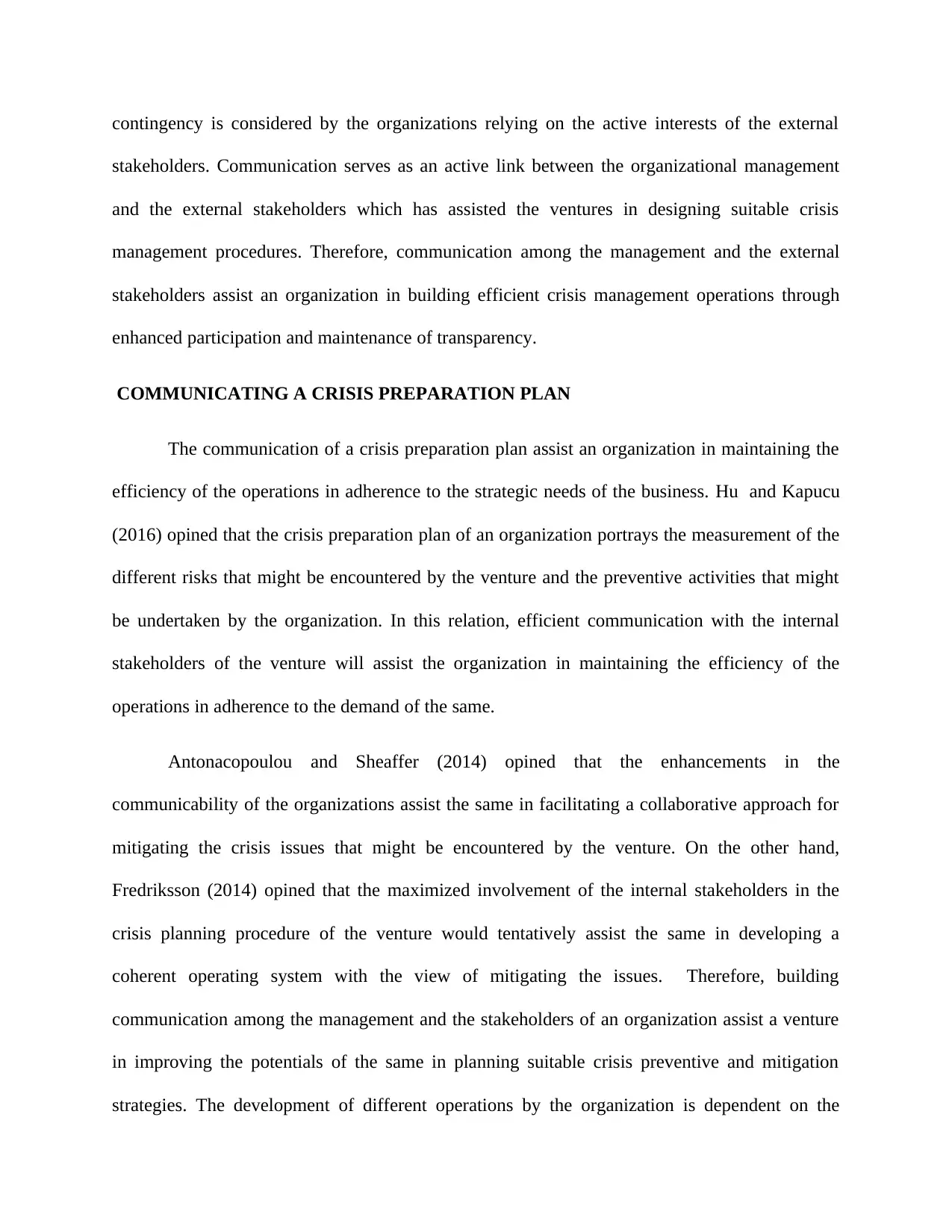
contingency is considered by the organizations relying on the active interests of the external
stakeholders. Communication serves as an active link between the organizational management
and the external stakeholders which has assisted the ventures in designing suitable crisis
management procedures. Therefore, communication among the management and the external
stakeholders assist an organization in building efficient crisis management operations through
enhanced participation and maintenance of transparency.
COMMUNICATING A CRISIS PREPARATION PLAN
The communication of a crisis preparation plan assist an organization in maintaining the
efficiency of the operations in adherence to the strategic needs of the business. Hu and Kapucu
(2016) opined that the crisis preparation plan of an organization portrays the measurement of the
different risks that might be encountered by the venture and the preventive activities that might
be undertaken by the organization. In this relation, efficient communication with the internal
stakeholders of the venture will assist the organization in maintaining the efficiency of the
operations in adherence to the demand of the same.
Antonacopoulou and Sheaffer (2014) opined that the enhancements in the
communicability of the organizations assist the same in facilitating a collaborative approach for
mitigating the crisis issues that might be encountered by the venture. On the other hand,
Fredriksson (2014) opined that the maximized involvement of the internal stakeholders in the
crisis planning procedure of the venture would tentatively assist the same in developing a
coherent operating system with the view of mitigating the issues. Therefore, building
communication among the management and the stakeholders of an organization assist a venture
in improving the potentials of the same in planning suitable crisis preventive and mitigation
strategies. The development of different operations by the organization is dependent on the
stakeholders. Communication serves as an active link between the organizational management
and the external stakeholders which has assisted the ventures in designing suitable crisis
management procedures. Therefore, communication among the management and the external
stakeholders assist an organization in building efficient crisis management operations through
enhanced participation and maintenance of transparency.
COMMUNICATING A CRISIS PREPARATION PLAN
The communication of a crisis preparation plan assist an organization in maintaining the
efficiency of the operations in adherence to the strategic needs of the business. Hu and Kapucu
(2016) opined that the crisis preparation plan of an organization portrays the measurement of the
different risks that might be encountered by the venture and the preventive activities that might
be undertaken by the organization. In this relation, efficient communication with the internal
stakeholders of the venture will assist the organization in maintaining the efficiency of the
operations in adherence to the demand of the same.
Antonacopoulou and Sheaffer (2014) opined that the enhancements in the
communicability of the organizations assist the same in facilitating a collaborative approach for
mitigating the crisis issues that might be encountered by the venture. On the other hand,
Fredriksson (2014) opined that the maximized involvement of the internal stakeholders in the
crisis planning procedure of the venture would tentatively assist the same in developing a
coherent operating system with the view of mitigating the issues. Therefore, building
communication among the management and the stakeholders of an organization assist a venture
in improving the potentials of the same in planning suitable crisis preventive and mitigation
strategies. The development of different operations by the organization is dependent on the
⊘ This is a preview!⊘
Do you want full access?
Subscribe today to unlock all pages.

Trusted by 1+ million students worldwide
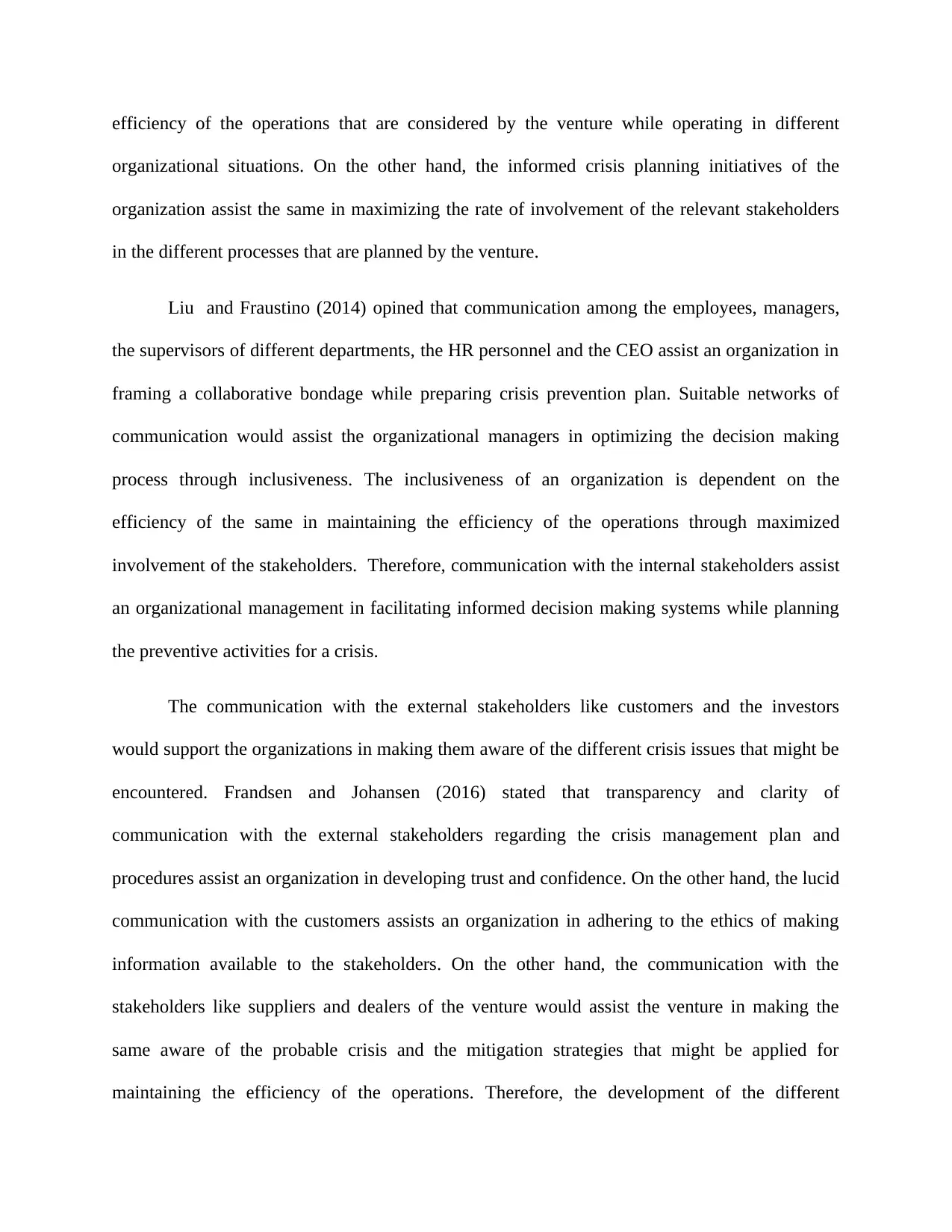
efficiency of the operations that are considered by the venture while operating in different
organizational situations. On the other hand, the informed crisis planning initiatives of the
organization assist the same in maximizing the rate of involvement of the relevant stakeholders
in the different processes that are planned by the venture.
Liu and Fraustino (2014) opined that communication among the employees, managers,
the supervisors of different departments, the HR personnel and the CEO assist an organization in
framing a collaborative bondage while preparing crisis prevention plan. Suitable networks of
communication would assist the organizational managers in optimizing the decision making
process through inclusiveness. The inclusiveness of an organization is dependent on the
efficiency of the same in maintaining the efficiency of the operations through maximized
involvement of the stakeholders. Therefore, communication with the internal stakeholders assist
an organizational management in facilitating informed decision making systems while planning
the preventive activities for a crisis.
The communication with the external stakeholders like customers and the investors
would support the organizations in making them aware of the different crisis issues that might be
encountered. Frandsen and Johansen (2016) stated that transparency and clarity of
communication with the external stakeholders regarding the crisis management plan and
procedures assist an organization in developing trust and confidence. On the other hand, the lucid
communication with the customers assists an organization in adhering to the ethics of making
information available to the stakeholders. On the other hand, the communication with the
stakeholders like suppliers and dealers of the venture would assist the venture in making the
same aware of the probable crisis and the mitigation strategies that might be applied for
maintaining the efficiency of the operations. Therefore, the development of the different
organizational situations. On the other hand, the informed crisis planning initiatives of the
organization assist the same in maximizing the rate of involvement of the relevant stakeholders
in the different processes that are planned by the venture.
Liu and Fraustino (2014) opined that communication among the employees, managers,
the supervisors of different departments, the HR personnel and the CEO assist an organization in
framing a collaborative bondage while preparing crisis prevention plan. Suitable networks of
communication would assist the organizational managers in optimizing the decision making
process through inclusiveness. The inclusiveness of an organization is dependent on the
efficiency of the same in maintaining the efficiency of the operations through maximized
involvement of the stakeholders. Therefore, communication with the internal stakeholders assist
an organizational management in facilitating informed decision making systems while planning
the preventive activities for a crisis.
The communication with the external stakeholders like customers and the investors
would support the organizations in making them aware of the different crisis issues that might be
encountered. Frandsen and Johansen (2016) stated that transparency and clarity of
communication with the external stakeholders regarding the crisis management plan and
procedures assist an organization in developing trust and confidence. On the other hand, the lucid
communication with the customers assists an organization in adhering to the ethics of making
information available to the stakeholders. On the other hand, the communication with the
stakeholders like suppliers and dealers of the venture would assist the venture in making the
same aware of the probable crisis and the mitigation strategies that might be applied for
maintaining the efficiency of the operations. Therefore, the development of the different
Paraphrase This Document
Need a fresh take? Get an instant paraphrase of this document with our AI Paraphraser
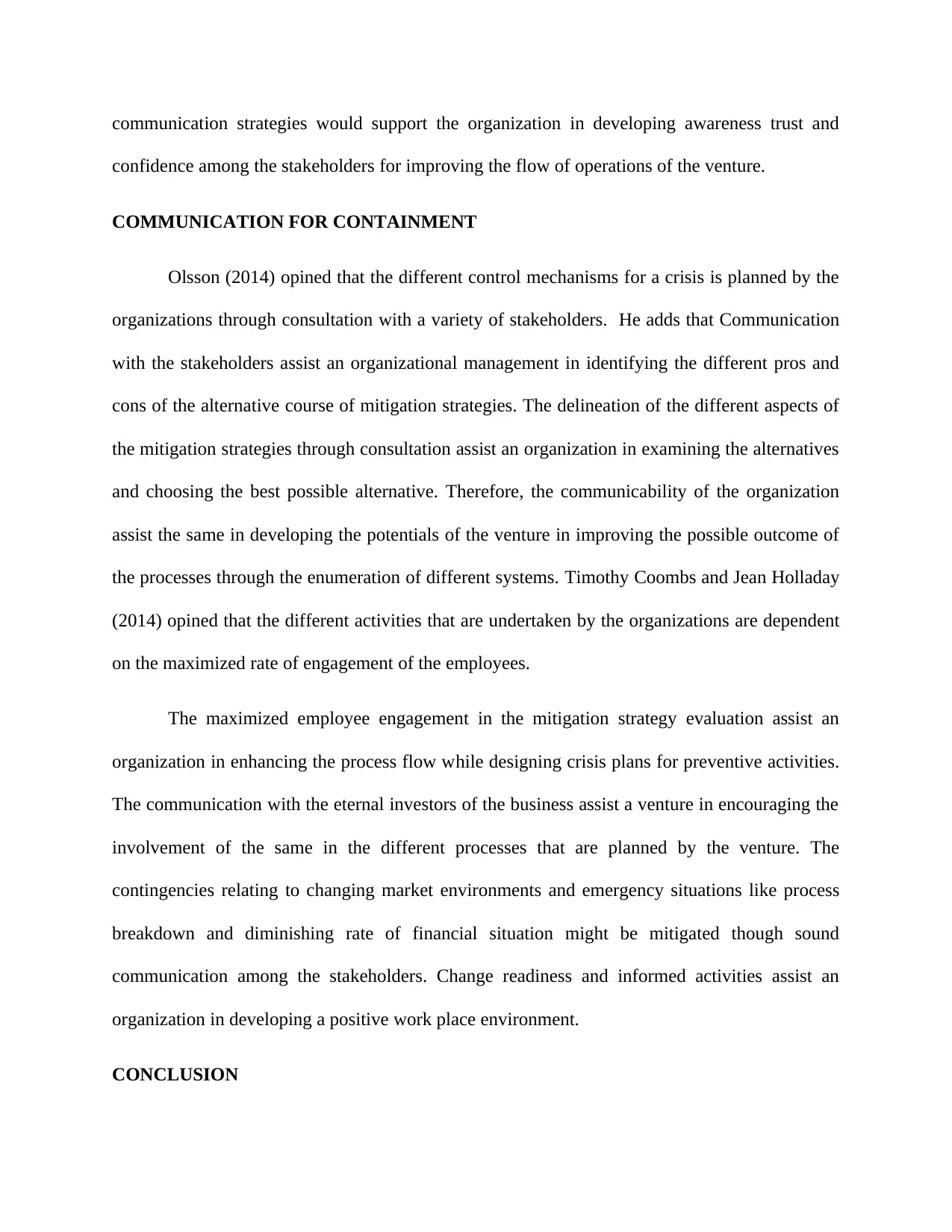
communication strategies would support the organization in developing awareness trust and
confidence among the stakeholders for improving the flow of operations of the venture.
COMMUNICATION FOR CONTAINMENT
Olsson (2014) opined that the different control mechanisms for a crisis is planned by the
organizations through consultation with a variety of stakeholders. He adds that Communication
with the stakeholders assist an organizational management in identifying the different pros and
cons of the alternative course of mitigation strategies. The delineation of the different aspects of
the mitigation strategies through consultation assist an organization in examining the alternatives
and choosing the best possible alternative. Therefore, the communicability of the organization
assist the same in developing the potentials of the venture in improving the possible outcome of
the processes through the enumeration of different systems. Timothy Coombs and Jean Holladay
(2014) opined that the different activities that are undertaken by the organizations are dependent
on the maximized rate of engagement of the employees.
The maximized employee engagement in the mitigation strategy evaluation assist an
organization in enhancing the process flow while designing crisis plans for preventive activities.
The communication with the eternal investors of the business assist a venture in encouraging the
involvement of the same in the different processes that are planned by the venture. The
contingencies relating to changing market environments and emergency situations like process
breakdown and diminishing rate of financial situation might be mitigated though sound
communication among the stakeholders. Change readiness and informed activities assist an
organization in developing a positive work place environment.
CONCLUSION
confidence among the stakeholders for improving the flow of operations of the venture.
COMMUNICATION FOR CONTAINMENT
Olsson (2014) opined that the different control mechanisms for a crisis is planned by the
organizations through consultation with a variety of stakeholders. He adds that Communication
with the stakeholders assist an organizational management in identifying the different pros and
cons of the alternative course of mitigation strategies. The delineation of the different aspects of
the mitigation strategies through consultation assist an organization in examining the alternatives
and choosing the best possible alternative. Therefore, the communicability of the organization
assist the same in developing the potentials of the venture in improving the possible outcome of
the processes through the enumeration of different systems. Timothy Coombs and Jean Holladay
(2014) opined that the different activities that are undertaken by the organizations are dependent
on the maximized rate of engagement of the employees.
The maximized employee engagement in the mitigation strategy evaluation assist an
organization in enhancing the process flow while designing crisis plans for preventive activities.
The communication with the eternal investors of the business assist a venture in encouraging the
involvement of the same in the different processes that are planned by the venture. The
contingencies relating to changing market environments and emergency situations like process
breakdown and diminishing rate of financial situation might be mitigated though sound
communication among the stakeholders. Change readiness and informed activities assist an
organization in developing a positive work place environment.
CONCLUSION
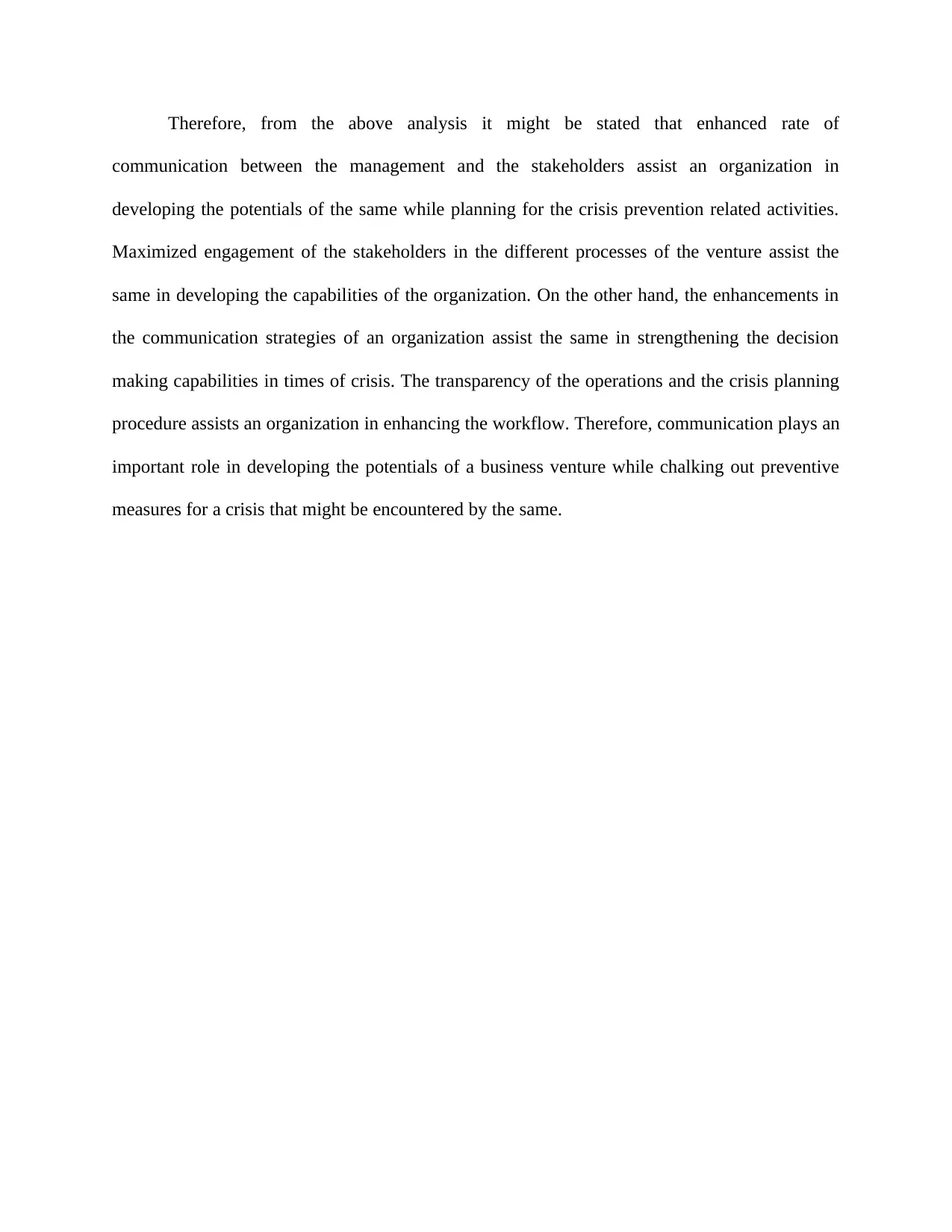
Therefore, from the above analysis it might be stated that enhanced rate of
communication between the management and the stakeholders assist an organization in
developing the potentials of the same while planning for the crisis prevention related activities.
Maximized engagement of the stakeholders in the different processes of the venture assist the
same in developing the capabilities of the organization. On the other hand, the enhancements in
the communication strategies of an organization assist the same in strengthening the decision
making capabilities in times of crisis. The transparency of the operations and the crisis planning
procedure assists an organization in enhancing the workflow. Therefore, communication plays an
important role in developing the potentials of a business venture while chalking out preventive
measures for a crisis that might be encountered by the same.
communication between the management and the stakeholders assist an organization in
developing the potentials of the same while planning for the crisis prevention related activities.
Maximized engagement of the stakeholders in the different processes of the venture assist the
same in developing the capabilities of the organization. On the other hand, the enhancements in
the communication strategies of an organization assist the same in strengthening the decision
making capabilities in times of crisis. The transparency of the operations and the crisis planning
procedure assists an organization in enhancing the workflow. Therefore, communication plays an
important role in developing the potentials of a business venture while chalking out preventive
measures for a crisis that might be encountered by the same.
⊘ This is a preview!⊘
Do you want full access?
Subscribe today to unlock all pages.

Trusted by 1+ million students worldwide
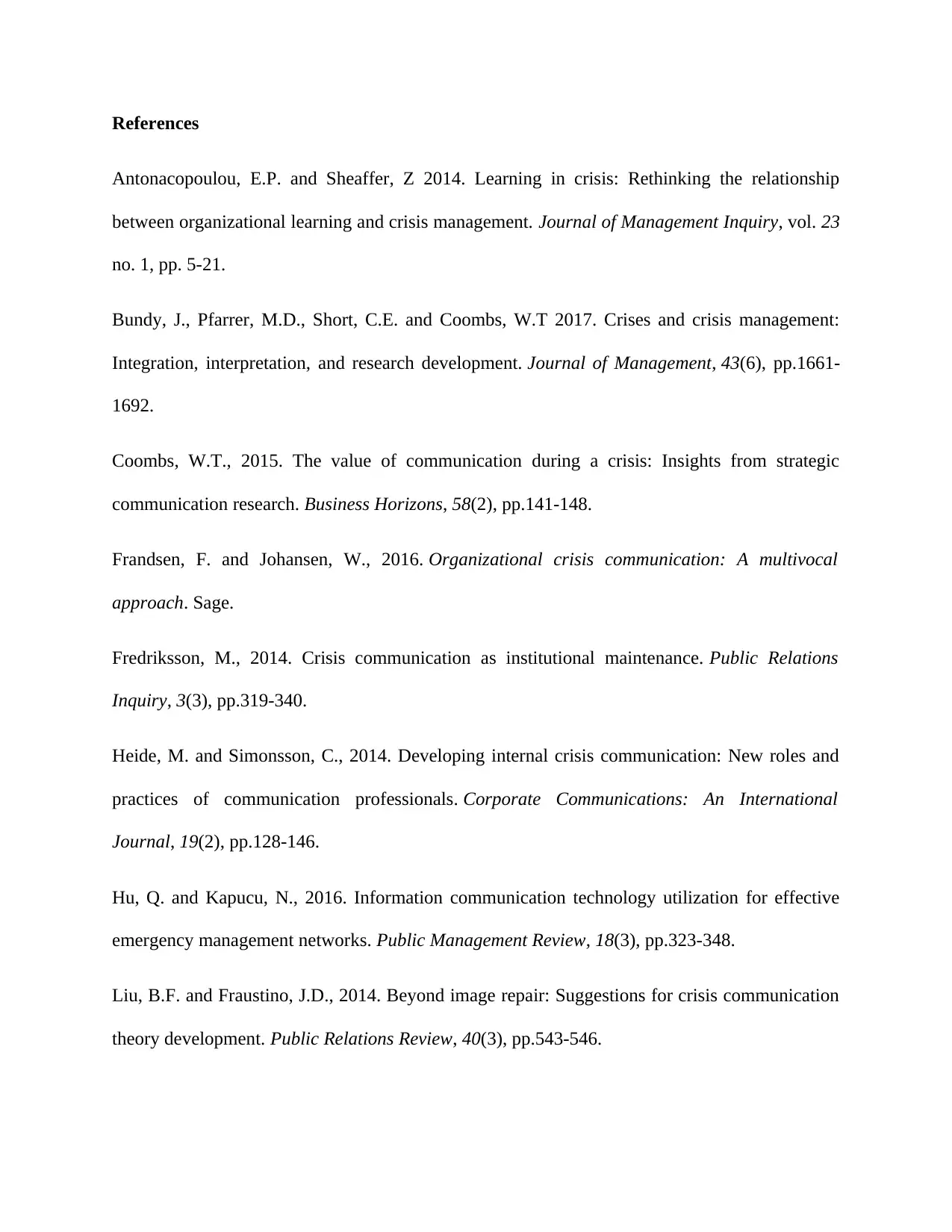
References
Antonacopoulou, E.P. and Sheaffer, Z 2014. Learning in crisis: Rethinking the relationship
between organizational learning and crisis management. Journal of Management Inquiry, vol. 23
no. 1, pp. 5-21.
Bundy, J., Pfarrer, M.D., Short, C.E. and Coombs, W.T 2017. Crises and crisis management:
Integration, interpretation, and research development. Journal of Management, 43(6), pp.1661-
1692.
Coombs, W.T., 2015. The value of communication during a crisis: Insights from strategic
communication research. Business Horizons, 58(2), pp.141-148.
Frandsen, F. and Johansen, W., 2016. Organizational crisis communication: A multivocal
approach. Sage.
Fredriksson, M., 2014. Crisis communication as institutional maintenance. Public Relations
Inquiry, 3(3), pp.319-340.
Heide, M. and Simonsson, C., 2014. Developing internal crisis communication: New roles and
practices of communication professionals. Corporate Communications: An International
Journal, 19(2), pp.128-146.
Hu, Q. and Kapucu, N., 2016. Information communication technology utilization for effective
emergency management networks. Public Management Review, 18(3), pp.323-348.
Liu, B.F. and Fraustino, J.D., 2014. Beyond image repair: Suggestions for crisis communication
theory development. Public Relations Review, 40(3), pp.543-546.
Antonacopoulou, E.P. and Sheaffer, Z 2014. Learning in crisis: Rethinking the relationship
between organizational learning and crisis management. Journal of Management Inquiry, vol. 23
no. 1, pp. 5-21.
Bundy, J., Pfarrer, M.D., Short, C.E. and Coombs, W.T 2017. Crises and crisis management:
Integration, interpretation, and research development. Journal of Management, 43(6), pp.1661-
1692.
Coombs, W.T., 2015. The value of communication during a crisis: Insights from strategic
communication research. Business Horizons, 58(2), pp.141-148.
Frandsen, F. and Johansen, W., 2016. Organizational crisis communication: A multivocal
approach. Sage.
Fredriksson, M., 2014. Crisis communication as institutional maintenance. Public Relations
Inquiry, 3(3), pp.319-340.
Heide, M. and Simonsson, C., 2014. Developing internal crisis communication: New roles and
practices of communication professionals. Corporate Communications: An International
Journal, 19(2), pp.128-146.
Hu, Q. and Kapucu, N., 2016. Information communication technology utilization for effective
emergency management networks. Public Management Review, 18(3), pp.323-348.
Liu, B.F. and Fraustino, J.D., 2014. Beyond image repair: Suggestions for crisis communication
theory development. Public Relations Review, 40(3), pp.543-546.
Paraphrase This Document
Need a fresh take? Get an instant paraphrase of this document with our AI Paraphraser
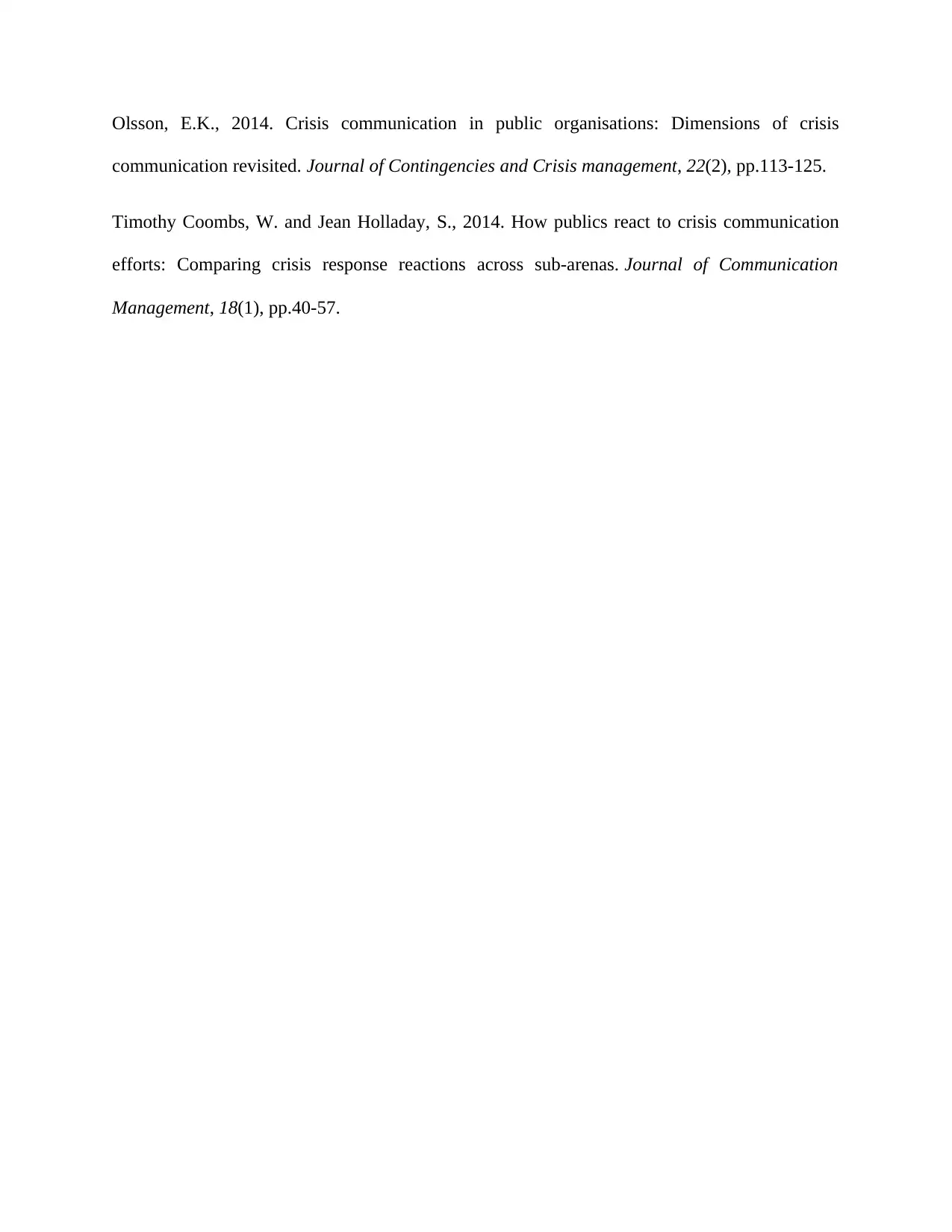
Olsson, E.K., 2014. Crisis communication in public organisations: Dimensions of crisis
communication revisited. Journal of Contingencies and Crisis management, 22(2), pp.113-125.
Timothy Coombs, W. and Jean Holladay, S., 2014. How publics react to crisis communication
efforts: Comparing crisis response reactions across sub-arenas. Journal of Communication
Management, 18(1), pp.40-57.
communication revisited. Journal of Contingencies and Crisis management, 22(2), pp.113-125.
Timothy Coombs, W. and Jean Holladay, S., 2014. How publics react to crisis communication
efforts: Comparing crisis response reactions across sub-arenas. Journal of Communication
Management, 18(1), pp.40-57.
1 out of 8
Related Documents
Your All-in-One AI-Powered Toolkit for Academic Success.
+13062052269
info@desklib.com
Available 24*7 on WhatsApp / Email
![[object Object]](/_next/static/media/star-bottom.7253800d.svg)
Unlock your academic potential
Copyright © 2020–2025 A2Z Services. All Rights Reserved. Developed and managed by ZUCOL.





